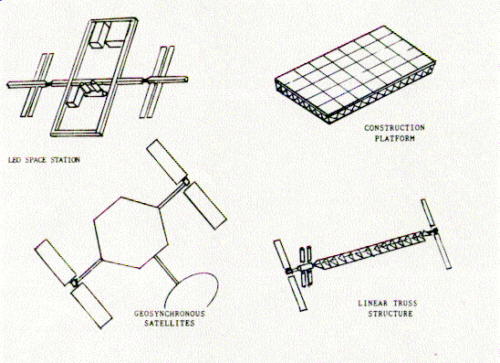|
astrotectonics:
an overview of non-terrestrial construction
By: Thomas M. Ciesla
page 2 of 5
Orbital Facililty Construction
The United States and the U.S.S.R. have maintained activities in soace for three decades though a variety of manned and unmanned crafts and satellites. After a series of short duration programs by each country, man now maintains a permanent presence in LEO with the launching of the U.S.S.R.'s MIR Space Station. The delpoyment of this station however, barely qualifies as being constructed in space, since MIR is a collection of Earth-built modules requiring only docking for assembly. To prepare for work on the U.S. Space Station, experiments have been performed by crews of the Shuttle (Card, M.E. et.al. 1986; Crockford, W.W. 1986), as well as Earth based crews operating in neutral bouyancy tanks (Covault, C.1987). results of each series of experiments show that current assembly times on Earth are comparable to actual assembly time in space.
Orbital structures consist of three basic classifications: Deployable, deployable-partially assembled, and space fabricated. An example of a deployable structure would be a typical satellite launched for communication or remote sensing. A deployable-partially assembled structure would be the U.S. Space Station which requires an orbitally assembled superstructure to support pressurized modules fabricated on Earth. An example of a space farbicated structure would be a space pplatform assembled in orbit using components fabricated in orbit from raw stock, using a device called a beam builder (Gvamichava, A.S. and Koshelev, V.A. 1984; Johnson, R.W. 1981; Kline, R.L. 1979).

Figure 2 Orbital Space Structures
Methods of asembly for orbital structures fall into two categories: (1) single point, and (2) variable point (Gould, C.K. 1981; Koelle, H.H. 1986). The single point method -- used primarily for linear truss platforms (see Figure 2) -- allows the structure being assembled to move about a fixed assembly/fabrication point. This method is ideally suited for Shuttle operations, where the holding fixtures will be located inclose proximity to the cargo bay and the structure can be assembled along a displaced X,Y axis. The variable point method uses an assembly stattion that moves along the X.Y axis of the structure being assembled. This system is ideally suited to large scale space fabricated structures using an assembly station consisting of beam builders and remote manipulators mounted onto a space crane which tracks along the trusswork of the structure being built.
|